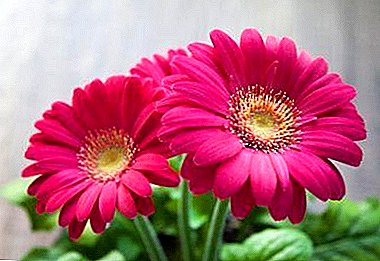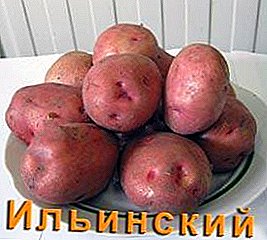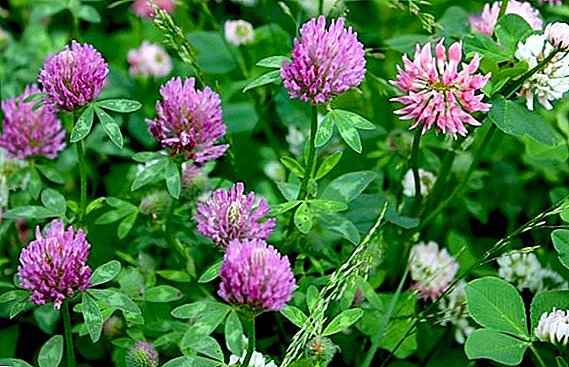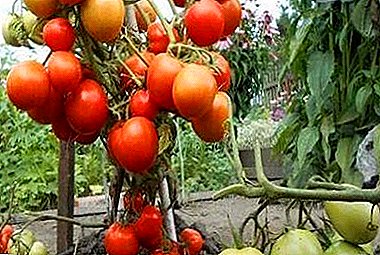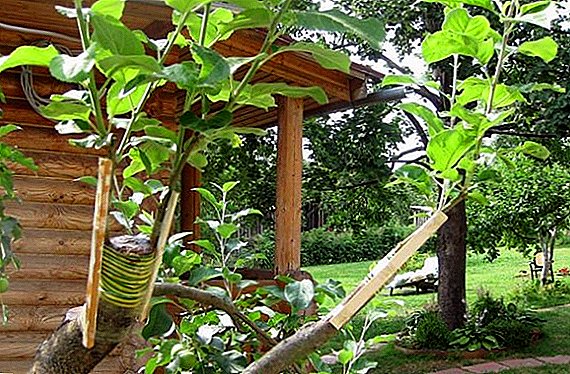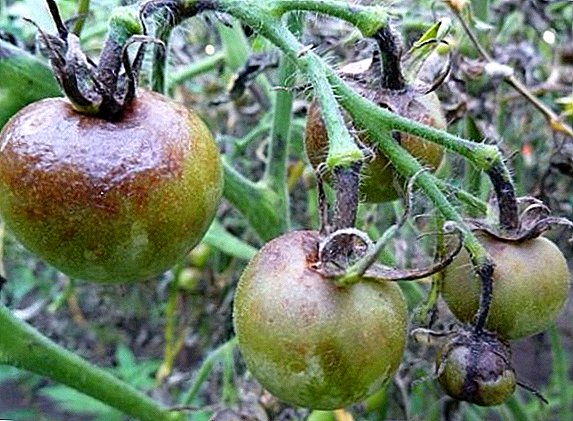 Having found signs of phytophtoras on their site, every gardener begins to sound the alarm. In the article we will tell about everything related to the disease and how to fight the blight on tomatoes in the greenhouse and in the open field.
Having found signs of phytophtoras on their site, every gardener begins to sound the alarm. In the article we will tell about everything related to the disease and how to fight the blight on tomatoes in the greenhouse and in the open field.
What is phytophthora: causes and signs of the disease
If you have not encountered the blight and do not know what it is, then, most likely, you have not tried to grow tomatoes in your garden. Phytophthora is the most dangerous disease of this plant, which is caused by the fungus phytophtorosis, which means “plant eater” in English. With its rapid development, it can destroy the crop of tomatoes in just a few days.
Causes of phytophthora
 At first, this infection infects potatoes, and after it switches to tomatoes. Therefore, one of the reasons for their infection is the proximity to the potato. Infection occurs because of high humidity, low or sudden changes in temperature, lack of sunlight, thickened planting of tomato bushes and an excess of nitrogen.
At first, this infection infects potatoes, and after it switches to tomatoes. Therefore, one of the reasons for their infection is the proximity to the potato. Infection occurs because of high humidity, low or sudden changes in temperature, lack of sunlight, thickened planting of tomato bushes and an excess of nitrogen.
One can notice the appearance of phytophtoras on plants in August and July. At this time, the day is still hot, the night is already cold, and in the morning there is a lot of dew, evaporation of which occurs slowly, especially from densely planted bushes. This moment is the best for the development of phytophthora.
Signs of phytophtora on tomatoes
At the first signs of phytophthora on tomatoes, black spots are first formed on the leaves, then the fruits suffer, and after them the stem is also affected. Black spots on the leaves in the rain are covered with a light oily bloom - this is a fungus. The inflorescences of tomatoes very quickly turn yellow, then turn black and fall off. Fruits become covered with black-brown traces, which soften over time. The stem is covered with uneven black spots. The disease rather quickly inhibits the bush, which subsequently leads to the death of the plant. 
Phytophthora: how to properly handle tomatoes in open ground
Tomatoes which are grown up in an open ground are most subject to this disease. And therefore, in order not to face this problem, it is necessary to carry out mandatory prevention.
Disease prevention
Let's see how to protect tomatoes from phytophthora. In order not to run into her in your garden, You must adhere to the following rules:
- The infection infects young bushes because of the untreated soil, so be sure to remove the weeds from the garden beds and do not plant tomatoes after potatoes and other crops that are also susceptible to phytophthora.
- Do not place the bushes very close to each other, as in the wet year this will provoke the development of phytophtoras.
- Watering of tomatoes should be only under the root, as the water on the leaves can cause disease.
- Place for growing tomatoes should choose a well-lit.
- Do not overdo it with the amount of nitrogen fertilizer applied.
Tomato Treatment
If you prevent the disease did not work, you need to know how to deal with blight on tomatoes. It is completely impossible to get rid of it, since the disease spreads from one bush to another and appears immediately on several plants.  The first thing to do in this situation is to isolate the affected bushes from healthy ones. It would be right to uproot them and burn them immediately to prevent them from spreading. If the phytophtora struck a large number of bushes, then chemical active substances will be needed.
The first thing to do in this situation is to isolate the affected bushes from healthy ones. It would be right to uproot them and burn them immediately to prevent them from spreading. If the phytophtora struck a large number of bushes, then chemical active substances will be needed.
When late blight of tomatoes treatment is carried out with preparations in powder form, which are diluted with water and sprayed on plants. The most effective of them are boric acid, "Gamar", "Fitosporin".
How to protect tomatoes from phytophthora in the greenhouse
Stagnant air and moisture evaporation are extreme conditions for growing tomatoes in the greenhouse. In this room, even though plants are less likely to be affected by diseases (since there is no direct source of infection), but if this happens, their spread is more intense. In order to prevent the destruction of tomatoes by phytophthora, greenhouses should be regularly aired and watered the bushes rarely, but many.
Did you know? To prevent the tomatoes from getting sick, preventive measures should be taken even before sowing, treating the seeds with a warm solution of potassium permanganate for 20 minutes.
Spraying for prophylaxis
 A very important question is how to spray tomatoes from phytophtoras, since an abundance of chemicals can make the fruit poisonous and unsuitable for consumption. In addition, during the treatments, you can ruin the bushes themselves, causing them to rot. In order not to harm the plant, you need to know how to splash tomatoes from diseases.
A very important question is how to spray tomatoes from phytophtoras, since an abundance of chemicals can make the fruit poisonous and unsuitable for consumption. In addition, during the treatments, you can ruin the bushes themselves, causing them to rot. In order not to harm the plant, you need to know how to splash tomatoes from diseases.
In preventive measures, it is necessary to water the tomatoes with a solution of copper sulphate within a week after planting. Then after another five days, it is necessary to treat the bushes with a decoction of horsetail, after which the leaves are sprayed with potassium iodide diluted with water. And after another five days, the plants are treated with Epin.
For prophylactic treatment, a solution from acidic whey of 2 l, a glass of ash and one spoon of honey per bucket of water will be suitable. This solution is sprayed with bushes every week. The most favorable time for all procedures is the first half of the day.
In order to avoid the reasons for the development of phytophthora in greenhouses, it is necessary to remove dust and cobwebs, monitor the cleanliness inside the room.
Phytophtora treatment on tomatoes
 If there was a phytophthora on tomatoes, then for many gardeners the question becomes how to deal with this scourge. Treat phytophthora in two ways:
If there was a phytophthora on tomatoes, then for many gardeners the question becomes how to deal with this scourge. Treat phytophthora in two ways:
- using chemical active substances;
- using folk remedies.
Important! When treating the remedies for phytophtoras on tomatoes, they are used together with a plant food that strengthens their immune system.When phytophthora on tomatoes is treated with chemicals such as "Alirin-B", "Gamar", "Baikal EM-1". Another effective remedy is Bordeaux liquid.
How to deal with blight folk methods
We list the most common folk remedies from phytophtora on tomatoes:
- Tincture of garlic with potassium permanganate. You will need 100 g of garlic minced in a meat grinder, which is poured with a glass of water and left for 24 hours. After a day, filter and dilute with 10 liters of water and 1 g of potassium permanganate. Spray the bushes need every other week.
- Milk serum. In a 1: 1 ratio, whey is diluted with water and tomatoes are treated from July daily.
- Ash. Seven days after disembarking and setting fruit, ash is sprayed between rows before watering.
- Tincture of rotten straw or hay. You need 1 kg of hay to pour 10 liters of water, add a handful of urea and leave for 3-4 days. After a while, strain and process the bushes in 1.5-2 weeks.
- Iodine with milk. They take 10 liters of water, 1 liter of nonfat milk, 15 drops of iodine, mix everything and process the bushes every two weeks.
- Salt. For one glass of salt, take a bucket of water and process large green fruits once a month.
- Copper sulphate solution. On a ten-liter bucket of water add 2 tbsp. l copper sulfate and the resulting solution watered the plant.
- Yeast. For 10 liters of water will need 100 g of yeast. Treat the plant when phytophthora appear.
- Wrapping the roots of seedlings with copper wire before planting or piercing the stems of tomatoes. It is necessary to heat the copper wire and cut into 4 cm pieces and then pierce the stem at a distance of 10 cm from the ground, insert the wire and bend its ends down.
Did you know? Copper sulfate can help get rid of phytophthora, but it is very dangerous for leaves. Any drops of the solution may burn the plant, after which it may die.
Varieties of tomatoes resistant to Phytophthora
Unfortunately, there are no varieties of tomatoes that will be completely resistant to phytophthora. Despite their great diversity, there are less and more resistant to the disease tomatoes.
For growing in greenhouse conditions are more suitable varieties of the determinant species. They are low, early and bring a good harvest.
Determinant Tomato Varieties:
- Grandee - stunted plants with fruit size up to 0.8 kg.
- Oak - bright red fruits weighing up to 0.1 kg.
- Perseus - red tomatoes of a rounded flat form.
- Persimmon - delicious orange tomatoes weighing up to 0.3 kg.
- Orange miracle - orange fruits came flattened down, with a high content of beta-carotene.

Important! When cultivating indeterminant varieties in their garden, they should be tied to high stands, since the main stem can break due to the heavy weight of the tomatoes.More resistant varieties of the indeterminant species are:
- De Barao. Tomatoes in the form of cream weighing up to 80 g
- Watermelon variety has green stripes, similar to watermelon. Fruits weighing up to 0.1 kg.
- Grandma's secret. Red-colored fruits are very fleshy, weighing up to 1 kg.
- Dragon Heart. Fruits of a raspberry-red shade with a fleshy core and weighing up to 0.8 kg.

Prevention of phytophthora
Protecting tomatoes from phytophthora will help proper care of them. Care is carried out depending on the type of development, which, in turn, is divided into generative and vegetative.
When the vegetative method of growing plants grow quickly, but the fruits are formed slowly. And because of late fruit formation, especially in rainy summer, the phytophthora will not take long to come. And to prevent this, you need to carry out pasynkovanie. This will ensure improved air circulation and accelerate the growth of the fruit.
When the generative method is active fruiting. A large number of tomatoes on a bush leads to a stressful state of the plant, which reduces its resistance.  In order to prevent the occurrence of phytophthora, it is necessary to regulate the number of tomatoes on a bush. At an unfavorable time, it is better to reduce the number of fruits and remove peripheral buds. So you will ensure rapid ripening and increase plant resistance to diseases. In order to prevent the occurrence of phytophthora in rainy weather, even an immature crop can be harvested, this will help the plant to fight the disease.
In order to prevent the occurrence of phytophthora, it is necessary to regulate the number of tomatoes on a bush. At an unfavorable time, it is better to reduce the number of fruits and remove peripheral buds. So you will ensure rapid ripening and increase plant resistance to diseases. In order to prevent the occurrence of phytophthora in rainy weather, even an immature crop can be harvested, this will help the plant to fight the disease.
How to save and consume affected tomatoes
Tomatoes that have already caught phytophthora can be preserved by heat treatment. To do this, you need to pour 60 ° C water into the basin and lower the affected fruit into it. Be careful: tomatoes should warm up and not cook. When the water cools, add a new one until the tomatoes are fully heated. After the water treatment, the tomatoes are dried and placed in a dark place or on the windowsill for ripening. During warming up, spores of phytophthora die, and then tomatoes can be eaten. They can also be canned. At defeat of fruits to full blackening thermal influence will not help, and they should be utilized.
100% disposal of phytophtora can not guarantee any of the ways. However, to prevent the occurrence of the disease and to fight against late blight of tomatoes is in your power. To do this, you must comply with all the above recommendations, to carry out preventive measures, and then you will get a large crop of healthy tomatoes.


